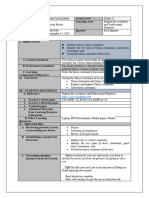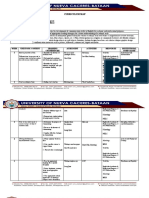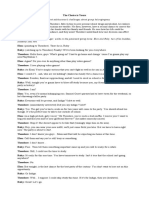Atg Eapp 2
Atg Eapp 2
Uploaded by
John Paul HolgadoCopyright:
Available Formats
Atg Eapp 2
Atg Eapp 2
Uploaded by
John Paul HolgadoOriginal Description:
Original Title
Copyright
Available Formats
Share this document
Did you find this document useful?
Is this content inappropriate?
Copyright:
Available Formats
Atg Eapp 2
Atg Eapp 2
Uploaded by
John Paul HolgadoCopyright:
Available Formats
MET # 2: Summarizing Academic Text and Thesis Statement Lesson #1: Nature of Academic Text
Prerequisite Content-knowledge: Academic Text and Text Structure
Prerequisite Skill: Techniques in Summarizing Academic Text
Prerequisites Assessment:
Pre-lesson Remediation Activity:
1. For Students with Insufficient Level on Prerequisite Content-knowledge and/or Skill(s): Making
students define what academic text is with regards to characteristics and examples.
2. For Students with Fairly Sufficient Level on Prerequisite Content-knowledge and/or Skill(s): Recitation
Introduction:
1. You will orient your students of the following:
Time frame: 2 days
Means of communication: face to face class
2. Present to the students the Knowledge (RUA) they are expected to gain from learning the
topic/lesson: The students will be able to…
Remembering: Remember the steps in summarizing
Understanding: formulate thesis statement of an academic text.
Applying: Make a summary of a given academic text based on the techniques learned.
3. Inform the students with the context where they can apply their learning:
The learners will learn the techniques in summarizing academic and how to locate thesis statement in a given text.
After discussing the techniques in summarizing, learners will be asked to make a summary applying the techniques
acquired.
4. Provide the overview of the lesson by summarizing the lesson in a nutshell.
The lesson is about summarizing and thesis statement. The students will be taught of the techniques to be used
when summarizing academic text. This will provide them the knowledge on getting the most important details on a
selection and locating the thesis statement.
Student’s Experiential Learning: (Note: Use the Flexible Learning Activity Identified for the topic/lesson relative
to the General Enabling Teaching Strategy)
Introduce the lesson by chunks (essential knowledge). Each chunk ends with a formative question that the students
should answer. If the students fail to answer the formative question satisfactorily, an immediate intervention should
be made readily available for students to access. This clarifies any misconceptions and would establish a solid
foundation of the knowledge, skills, and attitudes he/she should attain.
Chunk 1: Summarizing
Formative question: How do you summarize a text?
Chunk 2: Thesis Statement
Formative question: What is a thesis statement? Where can we locate a thesis statement? How do we formulate
thesis?
Synthesis
Provide the lesson’s synthesis by answering the formative questions in all of the lesson chunks.
Summarizing is creating a condensed version of a selection that covers a full-length text containing the main idea
and the most important ideas and points of the academic text.
Thesis Statement is the road map of the text. It is the central idea that gives the reader what is expected of the text.
It can be written in a sentence or two.
RUA of a Student’s Learning: This is the part where the students express their learning in their own unique ways.
They will manifest learning of the knowledge, skills, and attitudes they achieve in this lesson through their
individual learning style (visual, auditory, reading and writing, and kinesthetic).
The learners can now uniquely…
Remembering: Remember the steps in summarizing
Understanding: Summarized an academic text applying the techniques in summarizing
Applying: Formulate a thesis statement
Post-lesson Remediation Activity:
Based on your individual assessment of the student’s RUA of Learning, you will design remediation activity in the
form of inputs (reading texts, prompts, cloze completion, question and answer, etc.) that will address the identified
difficulties in the assessment.
Look for an academic text. Locate the thesis statement and make a summary.
You might also like
- Oral Communication DLL Week 3Document4 pagesOral Communication DLL Week 3raul.ladaojr100% (1)
- Degrees of Adjective Lesson PlanDocument8 pagesDegrees of Adjective Lesson PlanJohn Paul Holgado100% (3)
- FIDP Oral CommDocument8 pagesFIDP Oral CommGenelyn TabladaNo ratings yet
- Adaptive Teaching Guide - GUYO, SAIMONA M.Document4 pagesAdaptive Teaching Guide - GUYO, SAIMONA M.Sai Guyo100% (1)
- Cause and Effect Detail Lesson PlanDocument8 pagesCause and Effect Detail Lesson PlanJohn Paul Holgado100% (3)
- Curriculum Map (EAPP 1st Sem)Document11 pagesCurriculum Map (EAPP 1st Sem)Rodrick RamosNo ratings yet
- Inna Di DancehallDocument3 pagesInna Di DancehallCheri Brandy0% (1)
- Atg Eapp 8Document2 pagesAtg Eapp 8John Paul HolgadoNo ratings yet
- Atg Eapp 3Document2 pagesAtg Eapp 3John Paul HolgadoNo ratings yet
- Atg Eapp 9Document2 pagesAtg Eapp 9John Paul HolgadoNo ratings yet
- Atg Eapp 4Document2 pagesAtg Eapp 4John Paul HolgadoNo ratings yet
- Atg Eapp 6Document2 pagesAtg Eapp 6John Paul HolgadoNo ratings yet
- Atg Eapp 5Document2 pagesAtg Eapp 5John Paul HolgadoNo ratings yet
- Atg Eapp 1Document2 pagesAtg Eapp 1John Paul HolgadoNo ratings yet
- Atg Eapp 7Document2 pagesAtg Eapp 7John Paul HolgadoNo ratings yet
- Atg EappDocument3 pagesAtg EappJennifer Trimidal Bactong100% (1)
- Eapp First Quarter Performance TaskDocument6 pagesEapp First Quarter Performance TaskIt'smeashley100% (1)
- Film Review: Pasay City National Science High SchoolDocument2 pagesFilm Review: Pasay City National Science High SchoolReinier Buenviaje DelacruzNo ratings yet
- Cidam Oral CommunicationDocument3 pagesCidam Oral CommunicationDarrylNo ratings yet
- Eapp Lesson 1Document1 pageEapp Lesson 1Arcel V Luceno100% (2)
- DLL Grade 11Document7 pagesDLL Grade 11Marinel QuintoNo ratings yet
- Rubric - Manuscript Speech DeliveryDocument1 pageRubric - Manuscript Speech Deliverymememew suppasitNo ratings yet
- FIDP - ACAD 1st SemDocument11 pagesFIDP - ACAD 1st SemJieza May MarquezNo ratings yet
- EAPP Week 5 Lesson 5 Oulining An Academic TextsDocument19 pagesEAPP Week 5 Lesson 5 Oulining An Academic Textsggood bboyNo ratings yet
- PR2 ATG MET 1 (Repaired)Document26 pagesPR2 ATG MET 1 (Repaired)Mehaila SurmeonNo ratings yet
- 3rd Quarter Module 1 Selecting and Organizing InformationDocument15 pages3rd Quarter Module 1 Selecting and Organizing InformationKyle Randall Bustinera PatoNo ratings yet
- English 10 Curriculum Map Q4Document2 pagesEnglish 10 Curriculum Map Q4Casandra June VelascoNo ratings yet
- Eapp Module1 Q2W1Document14 pagesEapp Module1 Q2W1Lireea GhustaNo ratings yet
- Eapp Manifesto Lesson OutlineDocument9 pagesEapp Manifesto Lesson OutlineJodelyn Mae Singco CangrejoNo ratings yet
- Determining Concept by Definition, Explication and ClarificationDocument40 pagesDetermining Concept by Definition, Explication and ClarificationSusana fajardoNo ratings yet
- Reaction Paper DLP 1Document8 pagesReaction Paper DLP 1Majoy ManzanillaNo ratings yet
- LP RW Hypertext IntertextDocument3 pagesLP RW Hypertext IntertextButch0% (1)
- HUMSS - CW/MP11/12c-f6: Notre Dame of Abuyog, IncDocument2 pagesHUMSS - CW/MP11/12c-f6: Notre Dame of Abuyog, IncWilliam MoralesNo ratings yet
- G10 Module 2 Lecture Distinguish Technical Terms Used in ResearchDocument2 pagesG10 Module 2 Lecture Distinguish Technical Terms Used in ResearchReyann Dela CruzNo ratings yet
- Eapp Curriculum MapDocument3 pagesEapp Curriculum MapLorraine Tawatao100% (2)
- Fidp Oral ComDocument13 pagesFidp Oral ComJhessalyn Hawkins Pacis100% (1)
- Curriculum Map English 10Document16 pagesCurriculum Map English 10Mark Cesar VillanuevaNo ratings yet
- Class Orientation LP 2022 2023Document4 pagesClass Orientation LP 2022 2023renerose maligNo ratings yet
- Performance Task in Media and Information LiteracyDocument2 pagesPerformance Task in Media and Information LiteracyRosary Jean TrillanaNo ratings yet
- CS - EN11/12A-EAPP-Ig-j-20: MRS. JELLIE O. ANAYAEAPP12-Q2-M2Page 1 of 4Document4 pagesCS - EN11/12A-EAPP-Ig-j-20: MRS. JELLIE O. ANAYAEAPP12-Q2-M2Page 1 of 4Kd Cotton100% (1)
- WLP Eapp Week3Document7 pagesWLP Eapp Week3Imara AbdalaNo ratings yet
- Cmap EapDocument8 pagesCmap Eapunc bNo ratings yet
- Reading & Writing: Learning Module 2: Week 2 Patterns of Written Texts Across DisciplinesDocument6 pagesReading & Writing: Learning Module 2: Week 2 Patterns of Written Texts Across DisciplinesJenelle Salcedo100% (1)
- Learning Plan Week 2 EAPPDocument4 pagesLearning Plan Week 2 EAPPPristine EstorqueNo ratings yet
- DETAILED MET3 - LESSON1 Adaptive Teaching GuideDocument5 pagesDETAILED MET3 - LESSON1 Adaptive Teaching Guiderose ann abdonNo ratings yet
- Exam in EAPP 2019Document2 pagesExam in EAPP 2019Sumugat TricyNo ratings yet
- En10Rc-Iia-11: Transcode Information From Linear To Non-: Daily Lesson PlanDocument14 pagesEn10Rc-Iia-11: Transcode Information From Linear To Non-: Daily Lesson PlanLuo ShiNo ratings yet
- Grade 11 Oral Communication Lesson PlanDocument4 pagesGrade 11 Oral Communication Lesson PlanJerwin LualhatiNo ratings yet
- Lesson 1: Imaginative Writing Vs Technical/Academic/ Otherforms of Writing (Part II)Document11 pagesLesson 1: Imaginative Writing Vs Technical/Academic/ Otherforms of Writing (Part II)Rona Mae MagnoNo ratings yet
- ATG Melanie Kristine HablaDocument5 pagesATG Melanie Kristine HablaMelanie Kristine HablaNo ratings yet
- Module in Creative Nonfiction: Literary Elements As Techniques To Develop ThemesDocument6 pagesModule in Creative Nonfiction: Literary Elements As Techniques To Develop ThemesSalima A. PundamdagNo ratings yet
- Creative Writing: Learning Activity Sheet No. 3Document6 pagesCreative Writing: Learning Activity Sheet No. 3KAREN ARIAPNo ratings yet
- Reading and Writing Skills Lesson Plan (Quarter 4)Document6 pagesReading and Writing Skills Lesson Plan (Quarter 4)Janmyka Labunog100% (1)
- English For Academic and Professional Purposes: Quarter 1-Module 7 Writing A CritiqueDocument20 pagesEnglish For Academic and Professional Purposes: Quarter 1-Module 7 Writing A CritiqueLee Arne BarayugaNo ratings yet
- Unit 2-Lesson 3-Evaluating SourcesDocument32 pagesUnit 2-Lesson 3-Evaluating SourcesDale Jose Garchitorena100% (1)
- Chamber Theater Performance RubricDocument2 pagesChamber Theater Performance RubricLoriely Joy DuedaNo ratings yet
- EAPP Lesson 1Document17 pagesEAPP Lesson 1نجشو گحوشNo ratings yet
- Creative Non-Fiction LESSON 1 - Understanding Conventions of Traditional GenresDocument4 pagesCreative Non-Fiction LESSON 1 - Understanding Conventions of Traditional GenresQUEENY TOREJONo ratings yet
- Curriculum Map in English 4th QurterDocument4 pagesCurriculum Map in English 4th QurterMary Wayne ArzagaNo ratings yet
- Learning Plan Subject: English Year Level: Grade 8: PEAC2021Document5 pagesLearning Plan Subject: English Year Level: Grade 8: PEAC2021Annie Rose AnsaleNo ratings yet
- Flexible Instruction Delivery Plan UnfinishedDocument10 pagesFlexible Instruction Delivery Plan UnfinishedGensen Jey CruzNo ratings yet
- EdtpalessonplanwednesdayDocument4 pagesEdtpalessonplanwednesdayapi-284466937No ratings yet
- I. Techniques For Assessing Course-Related Knowledge and SkillsDocument6 pagesI. Techniques For Assessing Course-Related Knowledge and SkillsCarolina Flores GomezNo ratings yet
- Miss Universe NewsDocument1 pageMiss Universe NewsJohn Paul HolgadoNo ratings yet
- The Choice Is YoursDocument3 pagesThe Choice Is YoursJohn Paul HolgadoNo ratings yet
- Infrastructure Development in The Philippines Transportation System - GalapateDocument8 pagesInfrastructure Development in The Philippines Transportation System - GalapateJohn Paul HolgadoNo ratings yet
- How To Walk in A Stranger's House (Short Story) - MutyaDocument3 pagesHow To Walk in A Stranger's House (Short Story) - MutyaJohn Paul HolgadoNo ratings yet
- Stories of Love and AdventureDocument8 pagesStories of Love and AdventureJohn Paul HolgadoNo ratings yet
- LanguagesDocument30 pagesLanguagesCarlos FausNo ratings yet
- Mahatma Gandhi On Education in Vernacular LanguageDocument3 pagesMahatma Gandhi On Education in Vernacular LanguageVISHAL DASNo ratings yet
- Language Choice in Multilingual CommunitiesDocument24 pagesLanguage Choice in Multilingual CommunitiesAmalia AnggaristiNo ratings yet
- Macmillan Business-SpotlightDocument6 pagesMacmillan Business-SpotlightVikaNo ratings yet
- English Bach Unit 160001Document6 pagesEnglish Bach Unit 160001DeliaNo ratings yet
- Levels of Transmitting MessagesDocument23 pagesLevels of Transmitting MessagesKim BulawanNo ratings yet
- Mother Tongue Based ThesisDocument7 pagesMother Tongue Based Thesisxnehytwff100% (2)
- Wittgenstein On The Augustinian PictureDocument13 pagesWittgenstein On The Augustinian PictureMark Christian CatapangNo ratings yet
- Trip ReportDocument2 pagesTrip Reportapi-550526739No ratings yet
- Test 8th GradeDocument2 pagesTest 8th GradeEliza Sorina ȚopanăNo ratings yet
- Wasik From Grammar 2016 Internet PDFDocument384 pagesWasik From Grammar 2016 Internet PDFwiderarcNo ratings yet
- Evaluating Messages and PicturesDocument2 pagesEvaluating Messages and PicturesElijah Dela CruzNo ratings yet
- Bing 7Document3 pagesBing 738. Rut N. KustiyantiNo ratings yet
- Literary Criticism RubricDocument1 pageLiterary Criticism RubricScribdTranslationsNo ratings yet
- Tenses 2Document32 pagesTenses 2Sathyan LeninNo ratings yet
- 4th DLL GRADE 7 Interpersonal InformationDocument6 pages4th DLL GRADE 7 Interpersonal InformationAnne Darice CorderoNo ratings yet
- Conjunctions (Connectors) Review SheetDocument3 pagesConjunctions (Connectors) Review Sheet다옌No ratings yet
- Unit 05 Heroes - Lesson A PDFDocument64 pagesUnit 05 Heroes - Lesson A PDFsole garayNo ratings yet
- Quarterly Examination in ENGLISHDocument12 pagesQuarterly Examination in ENGLISHFlores MhackyNo ratings yet
- поурочный план англ яз (1)Document2 pagesпоурочный план англ яз (1)jgg27mx4tkNo ratings yet
- Hanks, William F. 1984. ''Sanctification, Structure, and Experience in A Yucatec Ritual Event''Document37 pagesHanks, William F. 1984. ''Sanctification, Structure, and Experience in A Yucatec Ritual Event''Alex ColmanNo ratings yet
- TheoreticalDocument2 pagesTheoreticalElLa LibresNo ratings yet
- 3 Meanings and Usages of The Mexican Spanish Expression ¡Órale!Document9 pages3 Meanings and Usages of The Mexican Spanish Expression ¡Órale!Speaking LatinoNo ratings yet
- Lavender LanguageDocument13 pagesLavender LanguageKyla Katrinne AsenjoNo ratings yet
- My Skripsi Fitri Full PDFDocument156 pagesMy Skripsi Fitri Full PDFMori Yohana SimamoraNo ratings yet
- Subiect Olimpiada XI Si XII - Etapa Locala - BilingvDocument2 pagesSubiect Olimpiada XI Si XII - Etapa Locala - BilingvLiviu Chiș-DanNo ratings yet
- Finals Conversation (Roman Letters)Document4 pagesFinals Conversation (Roman Letters)jpbNo ratings yet
- Opening A Restaurant: Questions 21 - 27Document6 pagesOpening A Restaurant: Questions 21 - 27bj10No ratings yet
- Comparatives and Superlatives: Unit 3Document12 pagesComparatives and Superlatives: Unit 3LILIAN DEL CARMEN RAMIREZ RIVASNo ratings yet
































































































